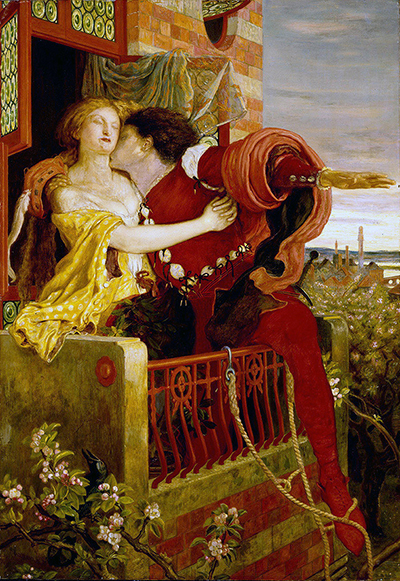The tale of Romeo and Juliet is well known, the world over.
Not only was it brought vividly to life by Shakespeare thanks to his superb iambic pentameter that gives the words their impact and emotional resonance, but it has been retold over and over again: the story of star-crossed lovers is one of the great storylines of humankind, or so it seems. Perhaps the best moment in the otherwise frustratingly tragic play is the scene now popularly known as the 'balcony scene' when Romeo, lovestruck, creeps close to his beloved's balcony and overhears her sighing out her love for him. He reveals himself to her and makes an equal declaration of love for her, and they share a very rare moment of harmony and understanding.
This painting, by Pre-Raphaelite/ Romantic Ford Madox Brown, depicts the moment when, having spent some blissful time together, Romeo really must return to his own quarters so they can make a plan to escape together. The balcony is small, but offer hints of wealth with the depiction of the many small panels of glass inset into the windows and lintel, the rich red of the wrought iron balcony and the accurately depicted Renaissance clothing which is richly dyed yellow and red, and which furls generously about both characters – a clear indication that extra fabric could be purchased merely for ornament or style, something that a poorer person would not be able to afford.
It is the moment just before dawn, when the world is light and seems full of promise: a clear allegory for the burgeoning relationship of the two – or what should be their relationship. Romeo is running late, and has hastened to begin his climb over the balcony, one leg thrust unceremoniously over the railing and foot caught in the first rung of his rope ladder, which trails from the balcony towards the ground. Despite his haste, Romeo lunges towards his love for one last, sustaining, kiss, stretched out to reach her. Her arms, in turn, are locked around him, as though she cannot bear to let him go, even as her eyes are closed and face turned upwards as though in ecstasy at the stolen moment of love.
Viewers who know the story must know that this is the pinnacle of their relationship, their one perfect moment before misunderstandings, deception and over-hasty action ruins everything: and this makes the painting all the more poignant to view. It can be seen in the Delaware Art Museum in the USA, and is in oil on canvas, measuring 135.5 by 93.3 centimetres – a portrait orientation that lends itself well to the scene.




